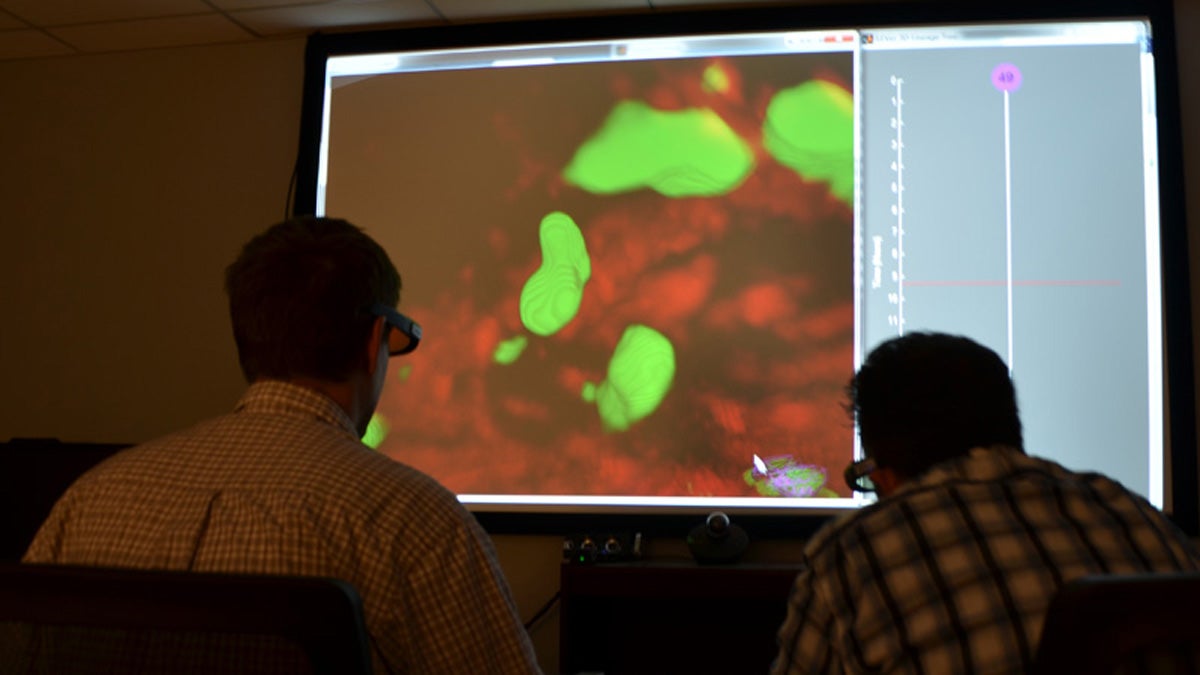Cell division, broadcast live and in 3D, offers fresh insight to researchers
Listen
Andrew Cohen (right) works on a movie about cells with doctoral researcher Eric Wait (left). (Courtesy of Drexel University)
It’s a dream job for a man who loves science, technology, video games, and movies.
It’s a dream job for a man who loves science, technology, video games, and movies: Drexel engineering professor Andrew Cohen develops custom-built computers and 3D movie technology that allow researchers to look at live cells in a whole new way – and to predict how they’ll change. Cohen recently stopped by for our series “So what do you do” where we pair researchers with lay people for down-to-earth conversations. He was interviewed by Philadelphia musician Keith Pierce.
“Let’s say you are talking to a nervous autodidact, who has no formal education,” said Pierce. “Maybe he took a wrong turn, and started playing music instead of going to college, how would you explain to this poor guy what you do? “I’m an engineering professor,” replied Cohen. “What I do, along with my students, is develop new math approaches, and build computer programs that let us better understand the complex biology that cells exhibit during disease, or as humans grow and develop.”
“Imagine if I followed you around for a week, and took a picture of you every five minutes,” said Cohen to Pierce, “how would we explore this data – and share it with the world?”
“The most cost-effective way is the same way that people play video games – using high-performance graphics that allow us to see you in 3D, so we can evaluate how you interact with others around you.”
Cohen doesn’t capture the images – they are sent to him by biologists all over the world who are working on specific problems, providing the computational help to understand what the data is trying to tell them.
“The end product shows image data and our analysis of the data, we’re drawing on top of the data to show you what we’re measuring,” he said. Pierce asked him to clarify this.
“Imagine you were to get a cartoon, and you go in and circle everything you think is interesting, and your highlights, your marks become visible. So, in my case, I’m saying ‘look at this cell right now – here it is a few minutes later and a few minutes after that.'”
Pierce asked Cohen what he has discovered so far, using this technology.
“Here’s the the reason why I’m still working in this arena,” answered Cohen. “In 2010, we discovered that we can predict what a stem cell is going to do when it divides, by looking at how it moves, its shape, and how its appearance is changing over time. We can tell you what sorts of daughter cells it’s going to produce as it divides.”
Pierce wanted to know if Cohen ever uses music in his cell movies – a question the engineering professor liked a lot.
“I once used a sound effect, the diving noise from a submarine, but I haven’t found the perfect music yet. If you’d like to compose something, I’d be very interested.”
Keith Pierce heads the Philadelphia band “Northern Arms” and said he’d be happy to write a tune for Cohen.
WHYY is your source for fact-based, in-depth journalism and information. As a nonprofit organization, we rely on financial support from readers like you. Please give today.




